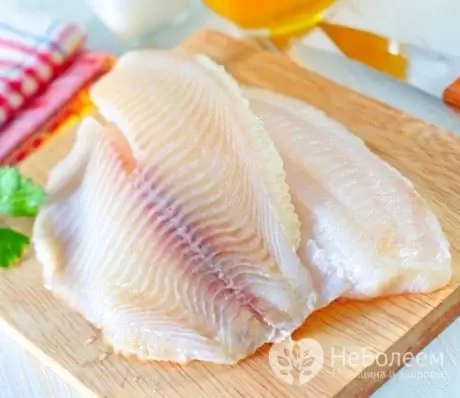- Author Rachel Wainwright [email protected].
- Public 2023-12-15 07:39.
- Last modified 2025-11-02 20:14.
Halibut
Halibut or halibut is the generalized name for four species of fish of the flounder family that live in the northern seas. Each of these species is found in the northern and eastern territories of Russia, having an important commercial value.
The ratio of BJU in the product

Source: depositphotos.com How to burn 186 kcal?
| Walking | 47 minutes |
| Jogging | 21 minutes |
| Swimming | 16 minutes |
| A bike | 27 minutes |
| Aerobics | 37 minutes |
| Household chores | 62 minutes |
All halibuts are divided into several main categories:
- White halibuts are the largest species, capable of reaching a length of about 5 meters with a mass of 300-350 kg. It includes two subspecies: these include White-bore and Atlantic halibut. Listed in the Red Book;
- Black (blue) halibuts are medium-sized fish. The length of the black halibut, as a rule, does not exceed 1.5 meters, and the weight is 45-50 kg;
- Arrowtooth halibuts are small fish, reaching 70-75 cm in length and weighing up to 2-3 kg. It is subdivided into Asian and American halibut;
- Halibut flounders.
The habitat of halibuts is the northern part of the Pacific Ocean to the coast of the Bering Sea and Japan. The fish prefers to live on the seabed, with an approximate depth of 2000 meters. In summer, halibuts rise slightly to the surface. The comfortable water temperature for this fish is from 3-6 degrees.
The fish feeds on small molluscs and larvae that live in large numbers on the ocean floor. Spawns in winter. The average life span of sea fish is 30 years, while halibut reaches sexual maturity at the age of 10-14 years. One halibut female spawns about 4 million eggs, which hatch after 16 days.
Halibuts differ from other fish of the flounder family in their elongated body, the color of which varies from olive to bluish-black. The width of an adult halibut is about a third of its length, which reaches 70-130 cm. The weight of this sea fish ranges from 3-30 kg.
A characteristic feature of halibut is the asymmetry of the skull, and both eyes of the fish are located on the right side of the head. The big mouth of the halibut is located under the lower eye. Despite some unpretentiousness, during the hunt, halibut turns into a swift predator.
Useful properties of halibut
Halibut fillet - this amazingly tasty fish - contains practically no bones. Its meat is rich in phosphorus, potassium, selenium and magnesium, as well as vitamins D, B, E, glutamic and nicotinic acids. The vitamin composition characteristic of halibut in combination with folic acid reduces the risk of cholesterol plaques on blood vessels, preventing thrombosis. Minerals fight free radicals while maintaining the integrity of cell membranes.
However, the greatest value of halibut fillets is, perhaps, Omega-3 fatty acids. They play an important role in the work of the cardiovascular system: they prevent arrhythmias, help cleanse the blood vessels. In combination with amino acids (there are about seven of them in halibut fillets), omega-3 fatty acids prevent the occurrence of malignant neoplasms. In addition, polyunsaturated fatty acids help preserve vision, preventing diseases such as macular degeneration, dry eye syndrome and many others. Halibut meat is very useful for the elderly, as its constituent elements prevent the death of brain cells, protecting the elderly from Alzheimer's disease.

Do not forget about such a valuable product as halibut caviar. Halibut caviar protein is absorbed many times faster than meat and is a dietary food. In addition, sea fish roe is rich in iron and iodine, protecting the body from anemia and thyroid diseases.
Caloric content of halibut
The calorie content of halibut is 103 kcal / 100 g. The nutritional value:
- Proteins - 18.9 g;
- Fat - 3 g;
- Carbohydrates - 0 g.
It should be noted that when frying, the calorie content of halibut increases several times, which is facilitated by the fish's ability to absorb fats. The leanest type of fish is white halibut, the meat of which has a lower fat content compared to other species.
Contraindications
Halibut is a rather fatty fish, so people with gastrointestinal disorders should be eaten with caution. Smoked and salted halibut is not recommended for children, people with kidney and liver diseases in the acute stage, as well as for heart patients and hypertensive patients.
YouTube video related to the article:
Found a mistake in the text? Select it and press Ctrl + Enter.






